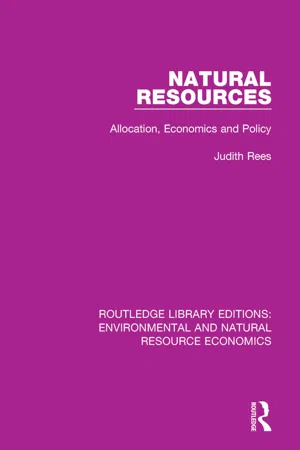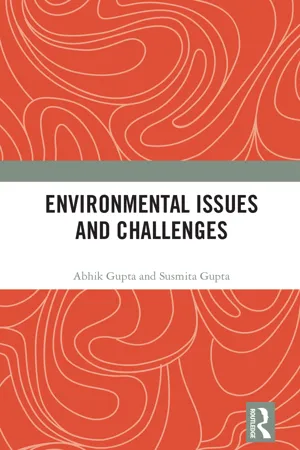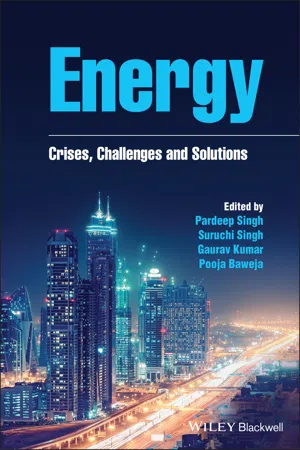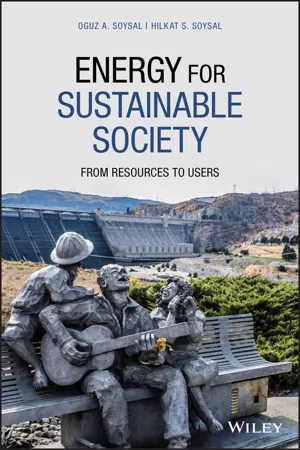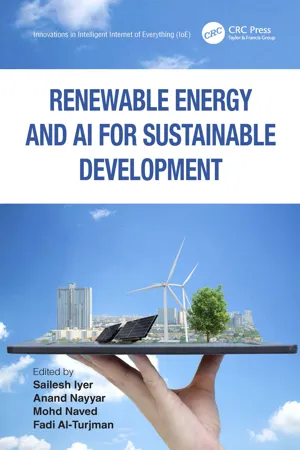Geography
Renewable Resources
Renewable resources are natural materials or energy sources that can be replenished over time, such as sunlight, wind, water, and biomass. These resources are considered sustainable because they are continuously available or can be naturally replaced. In geography, the study of renewable resources is important for understanding their distribution, utilization, and impact on the environment and human societies.
Written by Perlego with AI-assistance
Related key terms
6 Key excerpts on "Renewable Resources"
- eBook - ePub
Natural Resources
Allocation, Economics and Policy
- Judith Rees(Author)
- 2017(Publication Date)
- Routledge(Publisher)
6Renewable Resources: the diversity of perspectivesThe Concept of Renewability
The term ‘renewable resource’ has been used extremely widely in the literature, becoming almost a catch-all expression to encompass the highly diverse ‘products’ of physical environmental systems which are not classified as mineral stocks. The central characteristic of Renewable Resources is that they are thought to be capable of natural regeneration into useful ‘products’ within a timespan relevant to man. This distinguishes them from fossil fuels, which are transformed by use into forms of matter which cannot provide usable energy, and from the element minerals, which need to be reprocessed by man before they are available for reuse. However, the dividing-line between stock and flow resources is very fine and owes more to conventional patterns of thought than physical realities (see Figure 2.1 , p. 15 ).The strains in the definition are immediately evident in the case of land, which is, to all intents and purposes, a fixed stock, although it has a renewable capacity to support all forms of biological life. The fertility of the soil regenerates naturally when the land is not used intensively, but under all forms of modern agriculture it has to be managed and renewed artificially by man. Moreover, the effective supply of land available for this reproductive purpose can be decreased by urban-related developments and by agricultural practices which induce erosion and desertification. In reality, therefore, the continued flow of usable land is as much dependent on human decision and investment as is the rate of recycling of metallic minerals.Similarly, in the case of water, modern societies are rarely prepared to accept the limits imposed on population numbers, agricultural productivity or industrial activity by reliance on natural flows. Even in temperate areas, such as Britain, massive capital investment is required to augment natural availability by storage, recycling and the development of transfer networks. In this situation the concept of natural regeneration becomes redundant; availability is now a function of investment, and scarcity occurs not because of any absolute physical flow limitations but because of the lack of capital. The perceived need for flow augmentation and the costs involved will inevitably vary spatially; in part this is a result of the natural variability in precipitation, evapotranspiration and run-off regimes, but to a very large extent it reflects different socioeconomic circumstances, public policy objectives and institutional arrangements. - eBook - ePub
- Abhik Gupta, Susmita Gupta(Authors)
- 2023(Publication Date)
- Routledge India(Publisher)
Renewable and non-Renewable ResourcesDOI: 10.4324/9781032619873-55.1. Concept of resource: Renewable and non-renewable resource
The Cambridge Dictionary defines resource as “a useful or valuable possession or quality of a country, organization, or person.” It then defines natural resource as “things such as minerals, forests, coal, etc. that exist in a place and can be used by people” … or “oil, minerals, forests, etc. that exist in a place and that have economic value to a country.” It also adds that “Some natural resources, such as natural gas and fossil fuel, cannot be replaced.” Thus, natural resources from a human perspective are naturally occurring substances that have some economic value. However, from a broader ecological perspective, a resource is a substance or service that is required by plants and animals for their growth, maintenance, and reproduction, such as food, water, sunlight, and habitat. Humans have exploited natural resources since the dawn of civilization, although because of the small population size and low intensity of demand accompanied by lack of large-scale technology, the quantum of resource extraction was low and within sustainable levels.Natural resources can be classified in several ways. The terminology also varies according to various authors/schools of thought. The most common approaches are outlined here. One way to classify resources is to base it on “exhaustibility” and “renewability.” According to this approach, resources could be classified into the following categories:- Inexhaustible or perpetual resources: These include solar, wind, tidal, and atomic energy, rainfall, and hydropower. These resources are virtually available in unlimited quantities, which are not affected by human activities.
- Exhaustible resources: Exhaustible resources can be of the following types:
- Renewable Resources: Some resources can be regenerated through efficient management. Almost all biotic resources, that is, plants and animals can be regenerated if managed properly. Thus, forests can be regenerated through careful harvesting of the stock and planting to replenish the ones taken out. Similarly, rangelands, which sustain grazing animals, wildlife, and agricultural resources such as food crops, are all renewable. Soil and water can also be considered as Renewable Resources, although some scientists want to consider these under a separate category termed as cyclic resources. This is because these resources pass on an on through some processes to get renewed. These processes are influenced by human activities. Hence, these should be carefully monitored to ensure the cyclic regeneration of these resources. Otherwise, soil may lose its fertility or get salinized, waterlogged, or polluted. Water may become polluted to lose its required quality, or get depleted in a given area.
- eBook - ePub
Energy
Crises, Challenges and Solutions
- Pardeep Singh, Suruchi Singh, Gaurav Kumar, Pooja Baweja, Pardeep Singh, Suruchi Singh, Gaurav Kumar, Pooja Baweja(Authors)
- 2021(Publication Date)
- Wiley-Blackwell(Publisher)
This chapter focuses on various sources of RE, their importance, role in sustainable development. Its limitations and future prospects are also discussed in brief.7.2 Sources of Renewable Energy
RE sources are natural resources; therefore are inexhaustible, and energy released from them continuously flows in our environment. They represent a keystone to control the direction of the energy system towards sustainability. They include: solar energy, wind energy, geothermal energy, hydropower, bioenergy and tidal energy (ocean) (Figure 7.1 ).Overview of renewable energy resources.Figure 7.17.2.1 Solar Energy
The Sun is the main source of unlimited free solar energy (kabir et al. 2018 ). Solar energy has the highest possibility for producing safe, unpolluted and reliable energy from the Sun. It is used for light and also to produce heat and electricity. Earth continent receives solar energy more than 200 times the whole marketable energy consumption yearly by individuals (Ashokverghese 1998 ). On Earth, Sun's energy is the greatest source of everlasting energy and can be used directly (solar radiation) and in indirect (wind, hydro, biomass, ocean etc.) forms (Kumar et al. 2010 ). The concept of whole solar energy is related to harvesting and consumption of heat and/or light energy produced by the Sun and technologies (active and passive) involved in attaining goals. (Besarati et al. 2013 ). Solar energy technologies are classified into two types:7.2.1.1 Active Solar Energy Technology
The solar radiations are electromagnetic in nature and are used in producing electrical energy. These systems collect solar energy and convert it into heat and electrical energy by using electrical and mechanical equipment (fan, pump, solar water heater, etc.). These technologies are arranged into two classes: (i) photovoltaic technology and (ii) solar thermal technology (Herrando and Markides 2016 - eBook - ePub
Energy for Sustainable Society
From Resources to Users
- Oguz A. Soysal, Hilkat S. Soysal(Authors)
- 2020(Publication Date)
- Wiley(Publisher)
Humanity has, however, always challenged nature. As societies evolved, the need for energy has continuously increased to produce artificial light and heat when sunlight was insufficient or unavailable, produce more goods with less labor, and reach farther places in a shorter time. The industrial revolution in the mid‐nineteenth century answered the quest of humanity for more power. Since then, fossil fuels have become the essential sources of energy, while renewables turned out to be their alternatives. Fossil fuels provided great amounts of energy whenever needed and in the amounts needed, whereas energy flow from Renewable Resources was often unpredictable, variable in time, and insufficient for industrial development.Currently about 80% of the world's energy is supplied by burning non‐renewable natural resources. Over the last several decades of the twentieth century, however, the pursuit of sustainable and cleaner renewable energy options has accelerated because depletion of fossil fuel reserves has become more evident, and public awareness of environmental pollution and climate change increased. In addition, energy security concerns raised by dependency on foreign fossil fuels, especially petroleum, urged industrialized countries to develop energy policies requiring an increased use of renewable energy.Natural processes recreate continuously enormous amounts of energy that can be harnessed in many forms. Energy from sunlight, wind, water, hot springs, and combustible materials obtained from plants and animals are the most common resources that can be converted into practical secondary sources to supply energy need for various applications.Renewable energy sources are always replenished by natural processes at a rate that exceeds their rate of use; thus, they are not depleted by consumption. Potential energy of water, kinetic energy of wind, and radiant energy of sunlight are examples of renewable sources. Conventional hydroelectric power is the leading clean energy source among all renewables. The share of wind and solar power is growing in all regions of the world. Biofuels are consequences of solar energy and the natural water cycle. Plants fed by groundwater produce hydrocarbons by photosynthesis. Firewood, sugarcane, maize, soybean, palm, and many other plants are renewable biomass reproduced by natural water and carbon dioxide cycles. Such carbohydrate‐rich plants are used to produce ethanol, methanol, and other biofuels. Biodegradable waste can be transformed into biodiesel, which can be directly used in transportation vehicles. Ethanol and biodiesel are potential alternatives to petroleum products in the transportation sector. Use of combustible waste is increasing in district heating, electric generation, and synthetic fuel production. - Sailesh Iyer, Anand Nayyar, Mohd Naved, Fadi Al-Turjman, Sailesh Iyer, Anand Nayyar, Mohd Naved, Fadi Al-Turjman(Authors)
- 2023(Publication Date)
- CRC Press(Publisher)
2 An Overview of Global Renewable Energy ResourcesPresent Scenario, Policies, and Future ProspectsV. Manimegalai1 , V. Rukkumani2 , A. Gayathri1 , P. Pandiyan3 and V. Mohanapriya41 Department of EEE, Sri Krishna College of Technology, Coimbatore, Tamil Nadu, India2 Department of EIE, Sri Ramakrishna Engineering College, Coimbatore, Tamil Nadu, India3 Department of EEE, KPR Institute of Engineering and Technology, Coimbatore, Tamil Nadu, India4 Department of EEE, Bannari Amman Institute of Technology, Erode, Tamil Nadu, IndiaDOI: 10.1201/9781003369554-2CONTENTS
- 2.1 Introduction
- 2.2 Classification of Renewable Energy Sources
- 2.2.1 Biomass
- 2.2.2 Geothermal Energy
- 2.2.3 Hydro Energy
- 2.2.4 Solar Energy
- 2.2.4.1 Photovoltaic
- 2.2.4.2 Concentrating Solar Power
- 2.2.4.3 Solar Thermal Heating and Cooling
- 2.2.5 Wind Energy
- 2.2.6 Marine Energy
- 2.3 Renewable Energy and Sustainable Development
- 2.4 Renewable Energy and Climate Change
- 2.5 Policies and Incentives
- 2.6 Challenges Affecting Renewable Energy Sources
- 2.7 Benefits of Renewable Energy Sources
- 2.8 Conclusion and Future Scope
- References
2.1 Introduction
Human evolution has been based on the availability and use of energy. From the use of fire and animal power in the early days to the increasingly widespread use of electricity and cleaner sustainable fuels for various purposes, energy has been a fundamental driving force for human progress. In every country, the need for energy can be seen in a variety of sectors, including the provision of key services such as lighting, cooking, cooling, mobility, heating, and the functioning of machines and telecommunications equipment. Today, the inadequacy of reliable and clean energy supplies is regarded as one of the most considerable barriers to improving human wellbeing worldwide. Fossil fuels are expected to be exhausted due to the substantial growth of the population that has caused a significant change in the global energy demand. Numerous renewable energy resources have been used to combat this concern, such as wind, biomass, solar, geothermal, and tidal.- No longer available |Learn more
- (Author)
- 2015(Publication Date)
- Dunedin Academic Press(Publisher)
The distinction between renewable and non-renewable energy is at the heart of the current debate about measures to combat climate change. The distinction is not always clear-cut, since some ostensibly renewable materials (e.g. timber) could be depleted if not managed carefully, and windgeneration structures use a significant amount of non-renewable energy in their manufacture. However, other examples are more obvious; fossil fuels are clearly non-renewable, as are most forms of chemical energy. Nuclear energy is an interesting example of a supposedly ‘green’ energy source (it does not release greenhouse gases) but since it is, at present, reliant on uranium, an exhaustible fuel, it must be considered to be non-renewable.The principal sources of non-renewable terrestrial energy are: fossil fuels (coal, oil and natural gas) and nuclear processes. Renewable Resources are discussed in the following chapter.Fossil fuels
Fossil fuels are currently the largest suppliers of energy, although their role in global warming has meant that many countries are attempting to reduce their use in favour of more environmentally friendly options. The three main types of fossil fuel – coal, oil and natural gas – are all derived from decayed organic material that has been buried, compressed, subjected to various tectonic processes such as folding and faulting, and now forms part of the geological record. They actually form a spectrum of material, in the sense that oil and gas are merely the more mobile of the products of organic decay, and typically migrate upwards into different rock strata where they may become concentrated and exploited.Coal
Coal has been exploited as a fuel since at least the Bronze Age in Britain, where there is evidence of its use for funeral pyres, and in the first millennium BCE in China, for smelting copper. The Romans exploited coal in England and Wales, but it was only widely available as a fuel from about the thirteenth century, at first from easily accessible surface deposits, and later mined from shallow shafts. Deep coal mining became common during the Industrial Revolution, and by the 1830s in Britain, coal had replaced watermills as a source of power generation. Deep coal mining in Britain has been replaced by nearsurface quarrying (‘opencast mining
Index pages curate the most relevant extracts from our library of academic textbooks. They’ve been created using an in-house natural language model (NLM), each adding context and meaning to key research topics.
